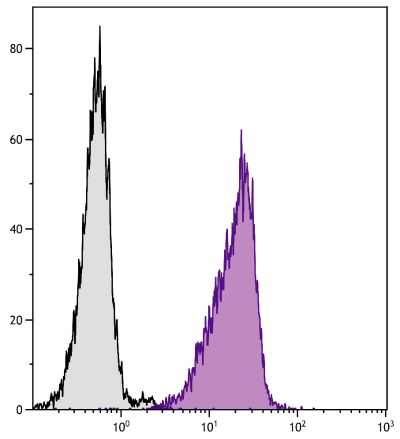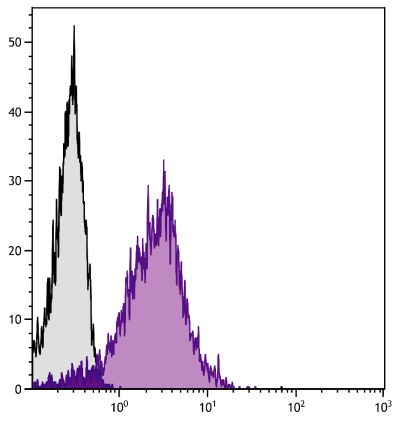Mouse Anti-Human CD13-APC/CY7 (22A5)
Cat. No.:
9556-19
APC/CY7 Anti-Human CD13 antibody for use in flow cytometry assays.
$273.00
| Clone | 22A5 |
|---|---|
| Isotype | Mouse (BALB/c) IgG2aκ |
| Isotype Control | Mouse IgG2a-APC/CY7 (HOPC-1) |
| Specificity | Human CD13 |
| Alternative Names | gp150, aminopeptidase N, APN, ANPEP |
| Description |
CD13, also known as aminopeptidase N, is a 150 kDa type II integral membrane glycoprotein. It is expressed on granulocytes, monocytes and their precursors, and on mast cells. CD13 is a zinc-binding metalloprotease that is involved in cell surface antigen presentation via its digestion of many MHC-bound regulatory peptides. |
| Immunogen | Osteoclasts from osteoclastomas |
| Conjugate | APC/CY7 (Allophycocyanin/Cyanine 7) |
| Buffer Formulation | Phosphate buffered saline containing < 0.1% sodium azide and a stabilizer |
| Clonality | Monoclonal |
| Concentration | Lot specific |
| Volume | 1.0 mL |
| Recommended Storage | 2-8°C; Avoid exposure to light; Do not freeze |
| Trademark Information | Cy® is a registered trademark of Global Life Sciences Solutions Germany GmbH |
| Applications |
Flow Cytometry – Quality tested 3,4 Immunohistochemistry-Frozen Sections – Reported in literature 1-3 Immunoprecipitation – Reported in literature 5 |
| RRID Number | AB_2927604 |
| Gene ID |
290 (Human) |
| Gene ID Symbol |
ANPEP (Human) |
| Gene ID Aliases | APN; CD13; GP150; LAP1; P150; PEPN |
| UniProt ID |
P15144 (Human |
| UniProt Name |
AMPN_HUMAN (Human) |
Documentation
Certificate of Analysis Lookup
Enter the Catalog Number and Lot Number for the Certificate of Analysis you wish to view
- 1. Horton MA, Lewis D, McNulty K, Pringle JA, Chambers TJ. Monoclonal antibodies to osteoclastomas (giant cell bone tumors): definition of osteoclast-specific cellular antigens. Cancer Res. 1985;45:5663-9. (Immunogen, IHC-FS)
- 2. Angelotti ML, Ronconi E, Ballerini L, Peired A, Mazzinghi B, Sagrinati C, et al. Characterization of renal progenitors committed toward tubular lineage and their regenerative potential in renal tubular injury. Stem Cells. 2012;30:1714-25. (IHC-FS)
- 3. Saho T, Kishida T, Hirano H, Hashikawa T, Shimabukuro Y, Murakami S. Induction of CD13 on T-lymphocytes by adhesive interaction with gingival fibroblasts. J Dent Res. 2003;82:893-8. (IHC-FS, FC)
- 4. Ashmun RA, Shapiro LH, Look T. Deletion of the zinc-binding motif of CD13/aminopeptidase N molecules results in loss of epitopes that mediate binding of inhibitory antibodies. Blood. 1992;79:3344-9. (FC)
- 5. Personal communication (IP)
See All References





